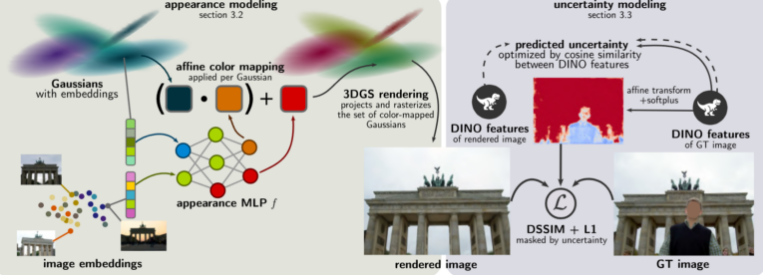Downcodes editor reports: Research teams from the Technical University of Prague in the Czech Republic and the Swiss Federal Institute of Technology in Zurich have recently made a major breakthrough. They developed an innovative method called WildGaussians, which significantly improves the performance of 3D Gaussian sputtering (3DGS) technology in processing unstructured structures. Capabilities in image sets. This technological breakthrough makes it possible to achieve high-quality 3D reconstructions using unstructured image sets such as landmark photos collected on the Internet, bringing new possibilities to fields such as virtual reality, augmented reality and computer vision. WildGaussians mainly solves problems such as appearance and illumination changes and moving object occlusion through two core components: appearance modeling and uncertainty modeling, and performs on challenging data sets such as NeRF On-the-go and photo tourism data sets. Excellent, its real-time rendering speed has also reached an impressive 117 images per second.
A research team from the Technical University of Prague in the Czech Republic and ETH Zurich in Switzerland recently introduced an innovative method called WildGaussians, which significantly improves the capabilities of 3D Gaussian sputtering (3DGS) technology when processing unstructured image sets. This breakthrough makes it possible to achieve high-quality 3D reconstruction from unstructured image sets such as landmark photos collected from the Internet.
WildGaussians mainly solves two key challenges: appearance and lighting changes, and occlusion problems of moving objects. The research team addressed these challenges by developing two core components: appearance modeling and uncertainty modeling.
Appearance modeling allows the system to process images taken under different conditions, such as different times or weather. The method uses a trainable embedding for each training image and Gaussian distribution, and adjusts the color of the Gaussian distribution to the corresponding shooting conditions through a neural network (MLP).
Uncertainty modeling helps identify and ignore occlusions such as pedestrians or cars during training. The researchers used pre-trained DINOv2 features to improve the system's adaptability to landscape changes.

In terms of performance, WildGaussians outperforms existing state-of-the-art methods on challenging datasets such as NeRF On-the-go and Photo Tourism datasets. At the same time, this method achieved a real-time rendering speed of 117 images per second on the Nvidia RTX4090 GPU.
Although WildGaussians has made significant progress in the field of 3D reconstruction, the researchers admit that the method still has some limitations, such as the representation of specular highlights on objects. They plan to further improve this approach in the future by incorporating techniques such as diffusion modeling.
This research opens up new possibilities for robust, versatile, and photorealistic 3D reconstruction from noisy user-generated data, which is expected to have a profound impact in multiple fields such as virtual reality, augmented reality, and computer vision.
The emergence of WildGaussians marks an important leap in 3D reconstruction technology, and its efficiency and high accuracy provide a solid foundation for many future applications. The editor of Downcodes hopes that this technology can be further improved in the future to bring us a more realistic and immersive digital experience.